
Poinsettia has long been a staple holiday crop plagued with high cost, low margins, and cultural challenges that result in lower grade and yield.
Poinsettia has long been a staple holiday crop plagued with high cost, low margins, and cultural challenges that result in lower grade and yield. Modern poinsettia genetics have helped growers increase yield and reduce production costs. Growing these newer varieties requires that we re-address long-held growing practices. This article is an attempt to do that.
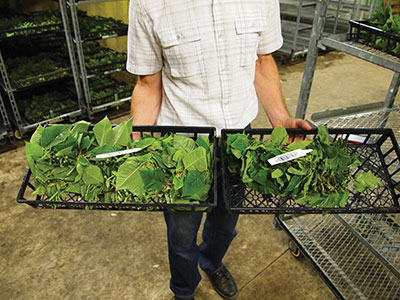 |
|
| Keep cuttings moist and turgid while handling. Advertisement
|
Poinsettia finishing is a process that can be dramatically influenced at all stages of growth. Good techniques at the early stages, beginning with propagation, continuing through the pinching process, are the best opportunities that growers have to influence yield and quality. We will work through the process of producing a pinched poinsettia crop, beginning with propagation.
PROPAGATION
Upon receiving cuttings, open the boxes quickly and stick or cool the cuttings. Keep cuttings moist and turgid while handling. Unpacking in a cooler 50 F/10 C is ideal. Store cuttings cool until sticking.
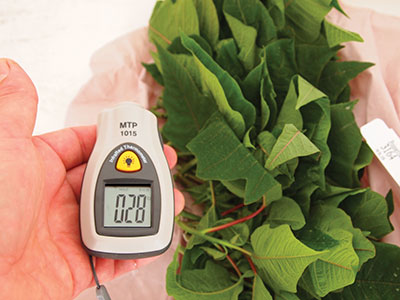 |
|
| Monitor temperatures throughout the unpacking, storing and sticking process. |
Prevent cuttings from getting hot during handling, and avoid storing cuttings outside of a cooler for long periods prior to sticking. Monitor cutting temperature throughout the unpacking, storing and sticking process. Sticking firm, turgid cuttings is a critical first step to avoid stress in propagation. Thorough sanitation of equipment, the propagation zone, along with foot baths, is reccomended to help prevent Erwinia.
Apply rooting hormone to the base of the cuttings. Most growers use some form of stabilized media for their propagation (Ellepot, Oasis, etc.). Use of a 12-13 strip tray will allow for proper spacing during propagation.
Get cuttings stuck and under mist ASAP to avoid wilt. A wetting agent can be applied after sticking, but only in low doses and single application. Repeated and/or high dosages of a wetting agent can result in damage to the leaf cuticle, and may result in leaf distortion and/or Botrytis.
Avoid acidification with phosphoric acid in the poinsettia propagation area, as this can also strip the leaf cuticle. The propagation environment should have a high humidity and moderate to heavy shade, depending on the location. If possible, keep night temps above 67 F / 19 C and days below 84 F / 29 C.
Keep mist higher early including some at night from Day One through Day Four. Apply enough mist to avoid wilted (rolled up) leaves. Callus starts forming in five to seven days after sticking.
Begin a fertility program of 150 ppm N in a balanced soluble fertilizer based on water quality. Feed three to four times per week.
Spray a broad spectrum fungicide going into the evening after reducing mist frequency, allowing the chemical to adhere to the plant. Begin reducing mist significantly as available, starting around Day Five to force root growth.
Apply only enough mist to keep leaves turgid. Excessive mist will significantly delay and reduce rooting.
Visible roots will develop by Day 10. Be off the mist completely by Day 14. Continue the fertility program of 150 ppm N feed every other irrigation. Begin PGR applications on varieties that are medium or higher vigour with Cycocel at 750 ppm, or in warmer conditions use a B-9 1000 ppm/Cycocel 500 ppm tank-mix spray. Apply first application at around Day 16 and again on
around Day 22.
FINISHING
Poinsettia prefers a well-drained media, with a maintained pH of 5.7-6.2. It should be grown with a constant liquid feed program of 200-250 ppm N. Use of CalMag feed is recommended as they need a good source of calcium. Care should be taken when using CalMag feeds as they are generally basic in reaction, and over time they can drive up the media pH.
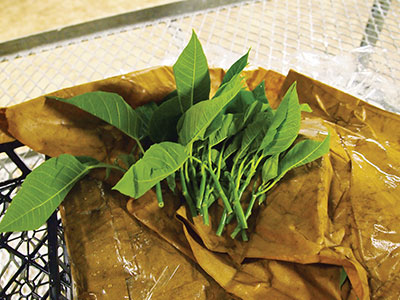 |
|
| Avoid storing cuttings outside of a cooler for long periods of time.
|
Avoid pH of 6.6 and higher at finish as this high of a pH and reduced fertility levels can contribute to bract edge burn and magnesium deficiencies. Maintain a media EC of 1.5-2.0. Note that poinsettia with a healthy root system will aggressively consume nutrition, often leading to a lower EC reading. This is not necessarily an indication to increase the EC of the fertility program, as long as the feed is being continuously applied. Using a poinsettia special feed, or the addition of supplemental molybdenum is recommended. Reduce feed to lower levels as the crop finishes in November.
The growing environment just prior to, through two weeks after the pinch, is critical. High humidity is needed to develop the branching evenly. Misting, quick boom passes, wetting floors, etc., are all useful tools to achieve this higher humidity environment.
From transplant to pinch, it is important to focus on managing the plant in preparation to the pinch. PGRs prior to the pinch can, and in many situations should, be applied.
Genetic and environmental factors come into play here. Some compact varieties may need none. Use of Cycocel 750 ppm, or, in warmer conditions, B-9 1000 ppm/Cycocel 500 ppm tank-mix is recommended. Application of Florel prior to and after the pinch is recommended on some genetics, but as a general rule I don’t advocate this additional step. Florel will have a growth-retarding effect that will continue after the pinch and may cause the plant undo stress.
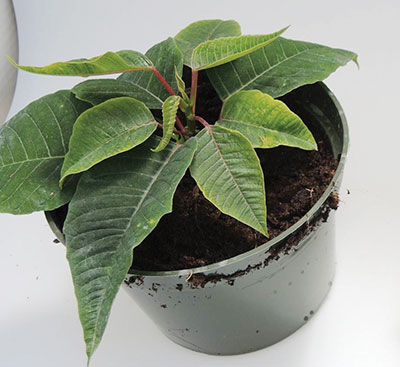 |
|
| Ready to pinch (13 days after transplant).
|
Pinch plants about 12-14 days after transplant and when they are rooting out into the pot. Plants need not be rooted out fully, just actively growing roots and tip. Pinch to leaf count based on finished specs (six to seven leaves after the pinch to produce a plant with six primary bracts). Don’t leave too many leaves. One of the most common challenges I see with newer genetics is leaving too many branches. This can cause wide plants and smaller bracts.
Height control has become the most complex part of the poinsettia growing process. It’s complicated by the diversity of vigour and timing in poinsettia genetics and the many height management tools now available.
The first key to good height management is measurement. Whether using a graphical tracking program, or height sticks, or simply measuring weekly, the process of measurement is the foundation to success.
The next critical aspect is the genetics of the plant being grown. Knowing the vigour, branching and timing of a variety is vital.
Another critical factor is scheduling. Scheduling different sizes becomes a factor of location, genetics and target sales date. For example, to grow a 6.5-inch, 16-inch tall poinsettia in Vancouver, it may be planted in Week 30. The same product from in San Diego may have a plant week of Week 33. Common sense is the basis for this success. As we know that starting an eight-inch pot requires more time than a four-inch pot; there are also differences in timing and vigour that come in to play within a given finished product. Lower vigour, early flowering varieties will need to be planted earlier to compensate – that’s common sense. Common sense, but complicated.
Specific breeding companies have support for scheduling. The key is to stay on track by managing the environment and using appropriate PGR chemical applications. There are many PGRs available that will have a strong response on poinsettia. I will focus on a few: straight Cycocel sprays, B-9/Cycocel tank mix sprays, and Bonzi micro drench.
For early PGR, a spray of Cycocel 750-1000 ppm tank-mix is recommended, or in the south in hotter conditions,
B-9 1000 ppm/Cycocel 500 ppm. By using these chemical sprays with light volume on the top of the plant, this will direct the PGR effect to focus on the most vigorous branches, evening out the crop. Avoid using drenches early, especially Bonzi, as this will have a strong effect on all branches and can contribute to apical dominance and unbalanced branching.
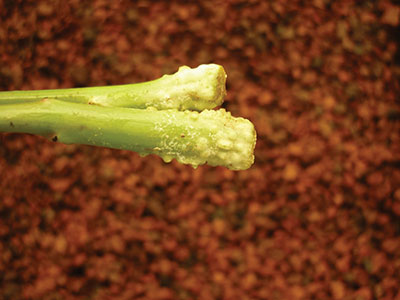 |
|
| A nice white callus eight days after sticking
|
Later in the crop cycle, Bonzi micro drenches are an excellent tool. Rates of 1/20th ppm to 1/8th ppm can be an excellent tool and can be applied late in the production cycle. Use very low rates, and if neccesary a repeat application can be done. Avoid Cycocel after Oct. 10, and B-9/Cycocel after Oct. 1, as this can result in bract size reduction and distortion.
Maintain temperatures in the greehouse of 65 F / 18 C or higher at night, and days below 90 F / 32 C during the active growing phase of the crop. Avoid high night temps above 75 F / 24 C during the initiation phase from mid-September through early October to prevent heat delay.
Avoid light pollution during night hours during this same period to avoid light delay as well.
Night temperatures can be reduced later in the crop cycle with many new varieties, reducing the energy cost of production. As the night temperatures are reduced, day temperatures can be increased by raising the vent temperatures. A typical cool finish regime is a night heating setpoint of 60-62 F / 15-16 C, and day vent temperature of 75-77 F / 24-25 C. Care must be taken on this strategy as many varieties will delay and have reduced bract size when finished with a cool night. Refer to breeder catalogues for cool compatible varieties.
SOME EXAMPLES OF COOL-SENSITIVE VARIETIES
We will quickly address a few other factors that influence poinsettia production that have not changed significantly with
new genetics.
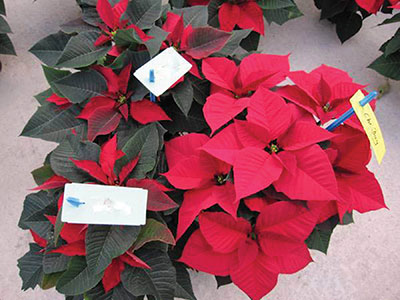 |
|
First is spacing. Space plants relative to the finished spec required. A typical 16-inch tall, six-bract poinsettia will be spaced on 13- to 14-inch centres.
Next, a quick rundown on insects and diseases. Whitefly, thrips, fungus gnats and various mites are the main pests of poinsettia. Pythium, Erwinia, Powdery Mildew, and Botrytis are the main diseases.
The change here is that biological control strategies are very good, allowing growers to grow poinsettia pesticide-free. In the Niagara area of Ontario, growers are virtually pesticide-free for poinsettia, something I never expected to see.
By using new poinsettia varieties and adjusting growing strategies, focusing on the early stages of growth, poinsettia quality and yields have never been higher.
 |
|
Gary Vollmer was educated at North Carolina State University with B.S. degrees in Horticulture and IPM. He worked for 32 years in growing and production. He then worked for three years as a Ball Seed Sales representative in Washington State. In 2010, he became a global product and technical manager for Ball FloraPlant and Selecta North America. His current responsibilities include technical support with growers on all Selecta crops. He is also responsible for working with breeding to develop future crops in all Selecta programs. Vollmer was a speaker at this year’s Greenhouse Canada Grower Day, held in June.
Print this page